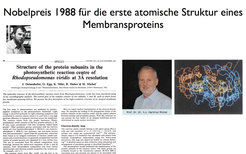Nobel Prize
Nobel Prize in Chemistry 1988 for Hartmut Michel together with Johann Deisenhofer and Robert Huber
The prize was awarded for the study of the three-dimensional molecular structure and the mode of action of the reaction centre of photosynthesis in the purple bacterium Rhodopseudomonas viridis.

Membrane-embedded proteins play a crucial role in the life of the cell, mediating processes as diverse as energy conversion, transport, and communication. In photosynthetic organisms, membrane-embedded proteins known as photosynthetic reaction centers capture light energy for photosynthesis, a process which powers nearly all life on earth. To understand how these and other proteins function requires a knowledge of their atomic-level structure, and this essential connection between structure and function lies at the heart of much of the work done at the Max-Planck Institute of Biophysics. However, when Hartmut Michel was a student, there were no known atomic-level structures of membrane proteins; it was widely believed that it was impossible to crystallize membrane proteins for X-ray crystallographic analysis.
While working with bacteriorhodopsin, another light-absorbing protein, Michel found early evidence that crystallization of membrane proteins might be achievable. Challenged by this, and with the support of Dieter Oesterhelt, Michel produced first two-dimensional, and then three-dimensional crystals of bacteriorhodopsin. Continuing his work with other membrane-bound proteins, Michel and colleagues at the Max Planck Institute of Biochemistry in Munich succeeded in crystallising the photosynthetic reaction center from the purple bacterium Rhodopseudomonas viridis, and determining its three-dimensional structure. This work represented a large step forward in understanding how sunlight powers life on earth, and laid the foundations for a new field: membrane protein crystallography. The work was honored with the Nobel Prize in Chemistry in 1988, awarded to Hartmut Michel and his colleagues Johann Deisenhofer and Robert Huber.
Related links
The original publication from 1988.
Nobel Laureate educational trail in Würzburg, Germany.











